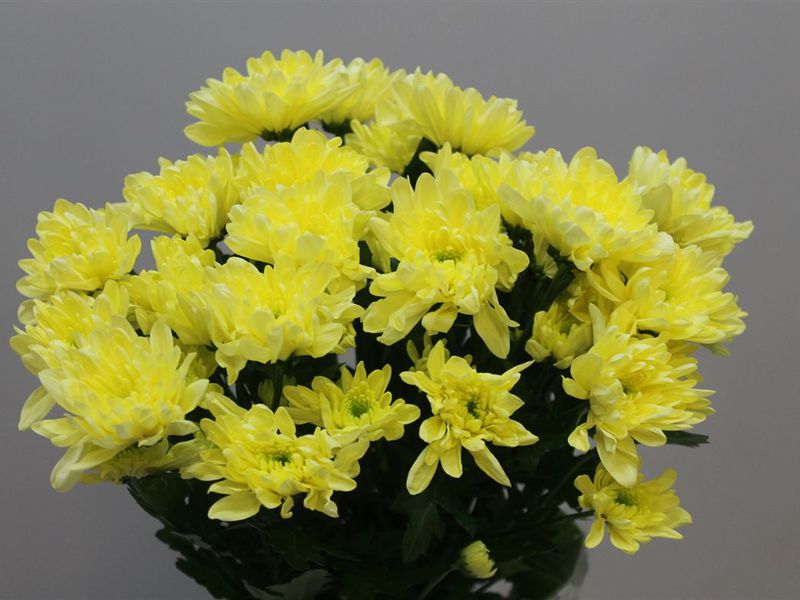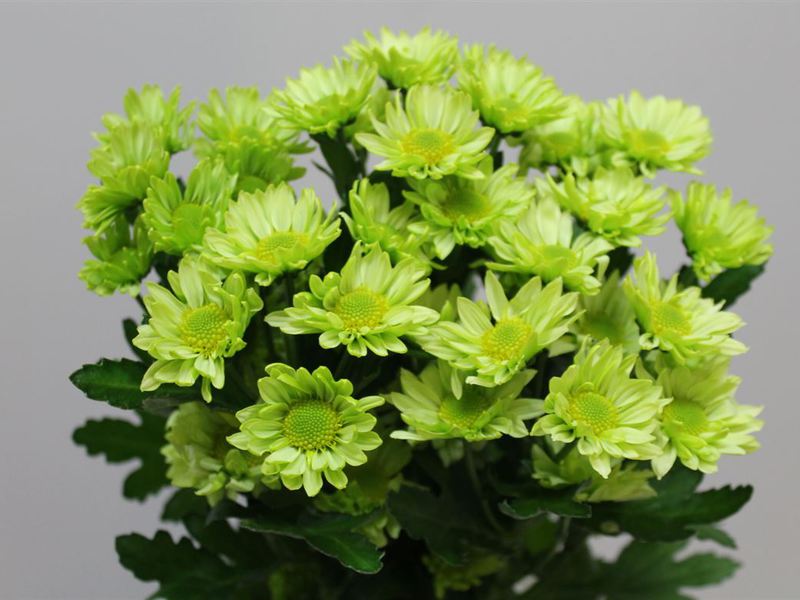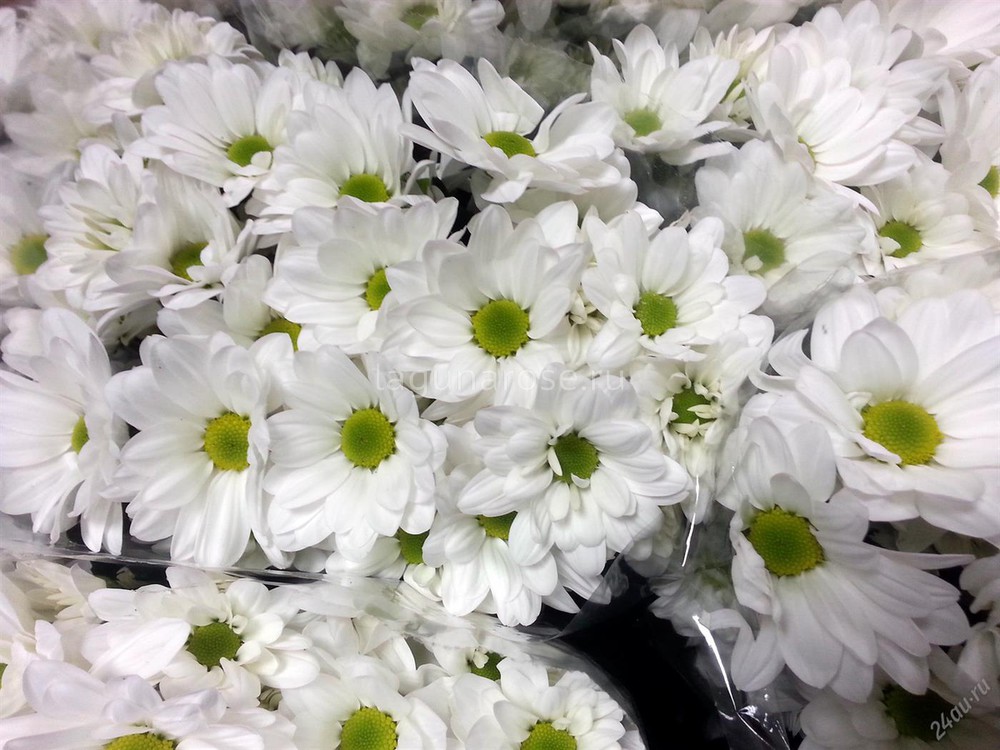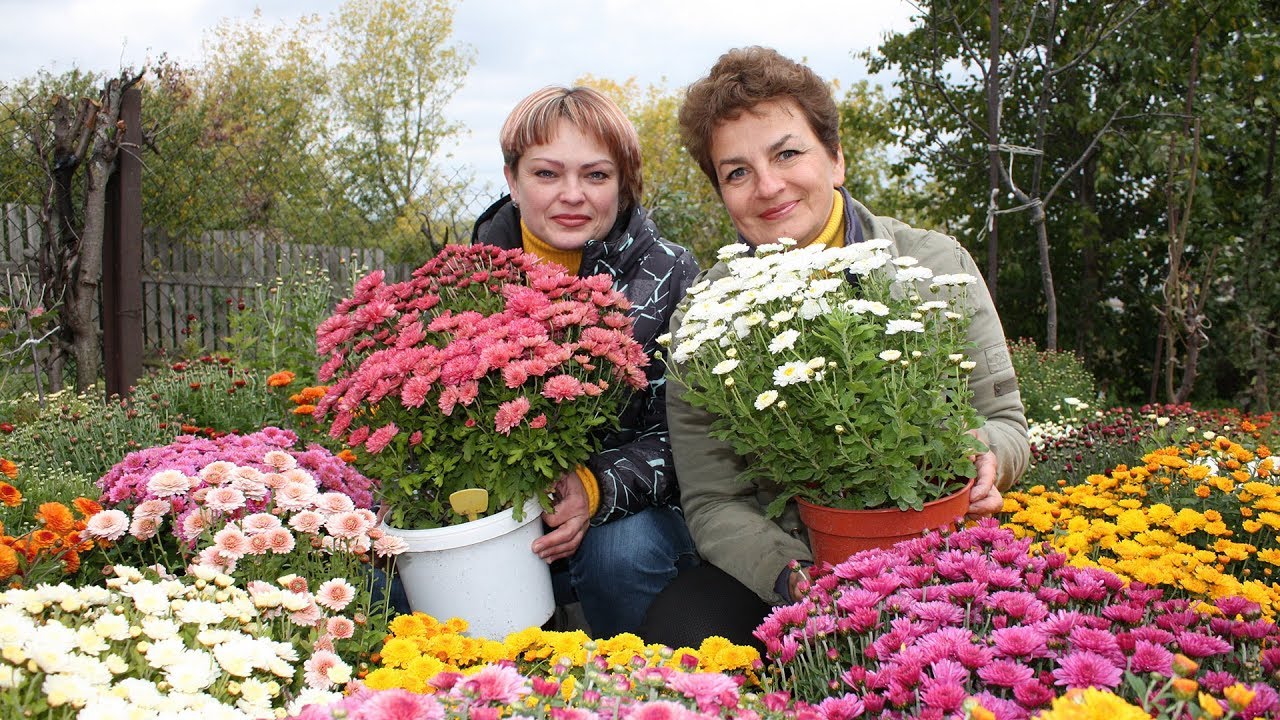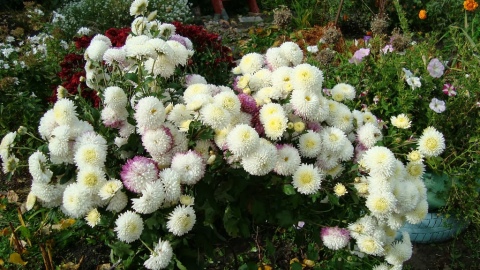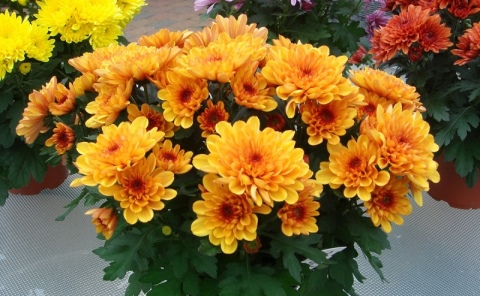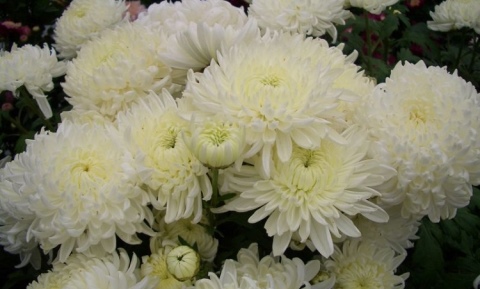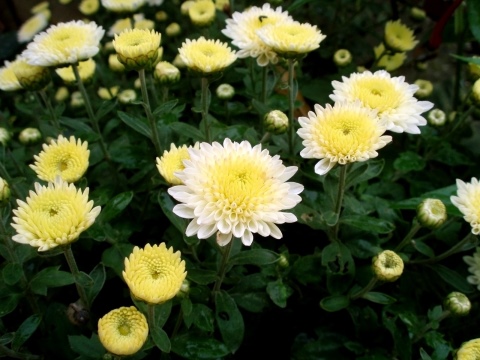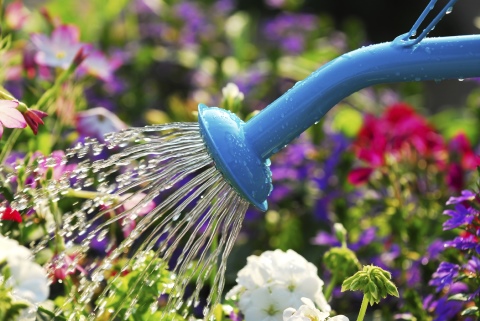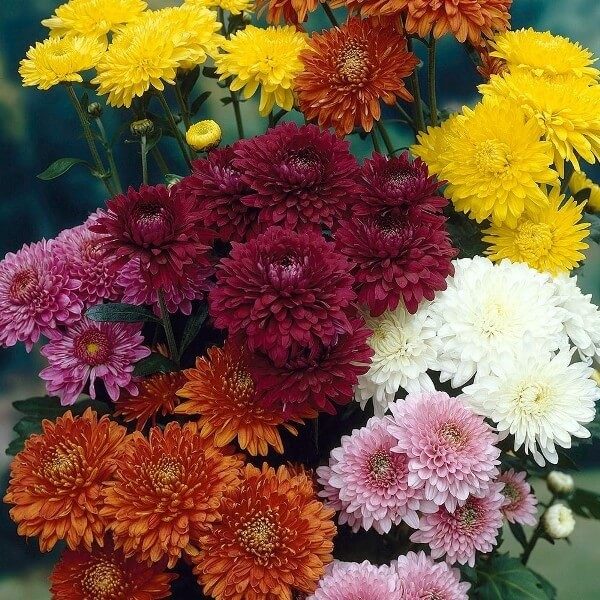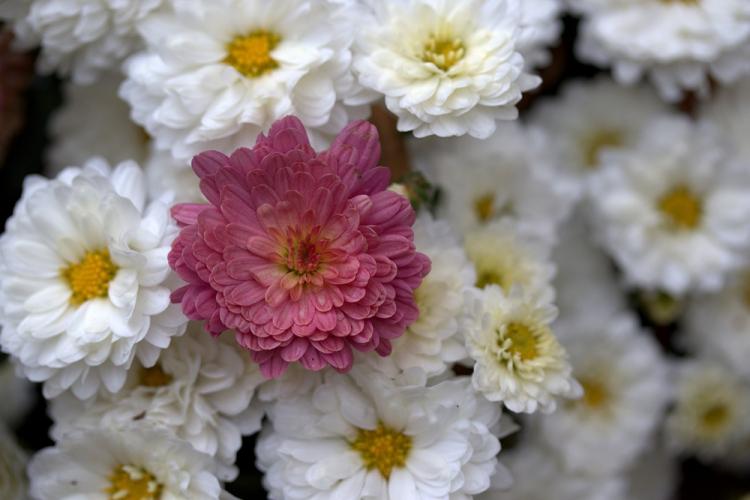Popular varieties
Among the several thousand varieties of chrysanthemums known today, more than two hundred are single-headed varieties. Not all of them, of course, but most are suitable for outdoor cultivation. Next, we will present 7 of the most popular varieties that can decorate the garden until the first frost.
Avignon

One of the largest-flowered chrysanthemums in this group. Its blossoming bud reaches 20 cm in diameter. The flower itself is magnificent: thick petals of a delicate light pink color with their tips rush upward, forming a lush ball. Avignon blooms late, in mid-November. The bush is tall, branched, of medium frost resistance, needs shelter for the winter.
Antonov

Chrysanthemum large-flowered Antonov is truly a royal flower. A large (12–15 cm) terry, snow-white bud on a long and strong stem looks great in a bouquet, a prefabricated composition and just by itself. A charming soft aroma, not typical for chrysanthemums, allows you to present such a bouquet as a present to a lady.
On sale you can often find chrysanthemum Antonov yellow, pinkish, orange and even blue. These are all "clones" of the same white flower, and the desired shade is achieved by adding a synthetic dye solution to the water.
Gagarin

The magnificent white chrysanthemum Gagarin is considered a novelty, since it was first presented at an international exhibition in 2014, where it won one of the main titles. It got its name in honor of the famous astronaut.
Magnum
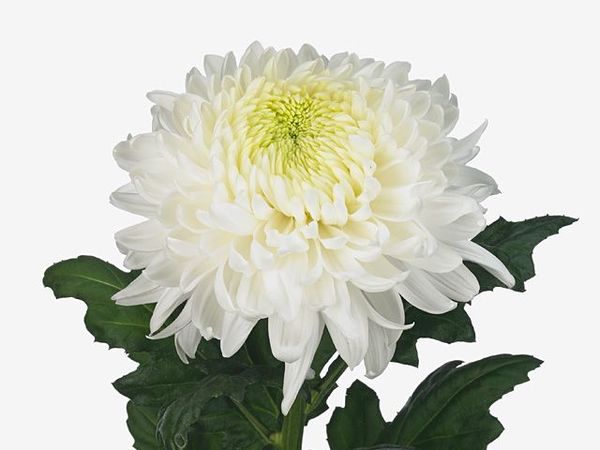
A unique snow-white flower that has won the love of florists, florists and ordinary consumers. The uniqueness of the chrysanthemum Magnum is that it was bred specifically for distillation, therefore it grows very quickly, is perfectly transported and stands in a vase for 30–40 days without losing its freshness.
The bud is spherical, densely double, about 20 cm in diameter, greenish middle. Despite the large flowers and powerful stems, the chrysanthemum bush is compact, medium-sized, looks great in flower beds.
Ping pong
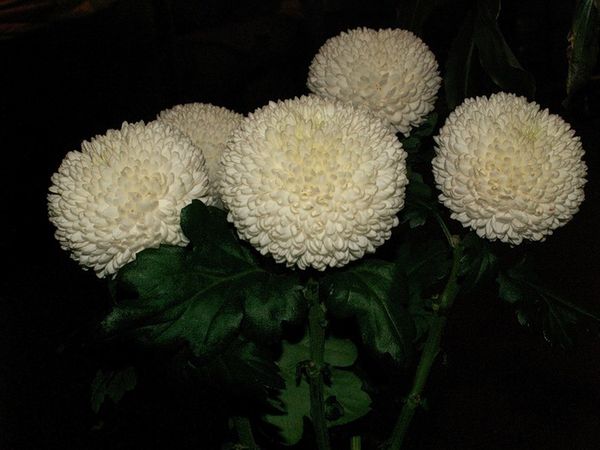
A feature of the Ping Pong chrysanthemum is its lush white or creamy round bud, reminiscent of a ping pong ball. For this similarity, she received such an unusual name.
The bush of the plant is tall (up to 1 m), the stems are strong, densely leafy. The flowers are not very large (5–7 cm in diameter), extremely stable when cut (up to 3 weeks), bloom in early October, bloom until the end of autumn under favorable weather conditions.
Peter

This majestic chrysanthemum cannot be overlooked in the garden. Its large (about 16 cm) bright yellow buds on a powerful stem enliven the site, house or holiday, filling it with solar heat and energy. The flower is magnificent both in a prefabricated and in a single composition, does not wrinkle at all during transportation, and for the first 3 days, even when cut, it can grow in the refrigerator.
The chrysanthemum bush Peter is low (up to 80 cm) and compact, for which we are very fond of gardeners.
Momoko

Incredibly beautiful and delicate pinkish flower. Its shades can range from light to deep pink. The shape of the bud is a perfect ball of dense petals folded so tightly that the middle is not visible. Momoko is translated from Japanese as "beautiful girl", which fully reflects the romantic appearance of the chrysanthemum.
All of these lovely flowers are mostly soft pastel shades.
If you want to spice up your garden with vibrant colors, look out for the gorgeous purple chrysanthemum Barca or the delicate lilac chrysanthemum Resume, which are also good for both cutting and decorating the site.
Yellow chrysanthemums in landscape design
Bright and lush single hats or cheerful sunny families of golden inflorescences, like no other plants, are able to decorate personal plots and city flower beds in mid and late autumn. They fit harmoniously into group plantings in gardens and flower beds and look elegant in solo flower beds.
 Ampelous yellow chrysanthemums
Ampelous yellow chrysanthemums
To create an attractive composition, it is enough to combine different varieties of flowers that differ from each other in color and shape. With the help of the Queen of Autumn, you can decorate lawns, the shores of natural and artificial reservoirs, open areas. Shades of yellow look spectacular against the background of emerald grass or brick-colored walls.
Harmonious compositions are made not only with other flowers, but also with fruit trees and shrubs, for example, apple, sea buckthorn, raspberry, barberry. Such multi-level combinations are based on the contrast of a rich shade of petals and greenery. To enhance the decorative effect, you can plant hydrangeas, ivy, dahlias, asters, Chinese lemongrass in the neighborhood.
Care
Chrysanthemums do not need to be carefully looked after during their growth, but the exception is the growing season.
If you pay due attention to flowers at this stage of growth, then they will also delight you with lush inflorescences and long flowering. Water the plant abundantly during the growing season, it prefers rainwater
Feed chrysanthemums, but only their roots. If the top dressing is foliar, then there is a possibility that it will burn the leaves.
The early varieties of chrysanthemums in the photo are no different from medium or late ones. But lovers of enjoying the beauty of plants not only in photographs, but also in life, and already at the end of summer, can safely plant all of the above varieties. Correctly chosen planting site and good care will make it possible to enjoy the beautiful flowering of chrysanthemums in the early stages.
How to grow chrysanthemums in the garden
Keep in mind: these flowers do not tolerate moisture retention and even the slightest darkening. So chrysanthemums should be planted in a sunny, preferably slightly elevated place. So you will definitely be sure that the flower shoots will not stretch too much and will not begin to bloom earlier. Just remember that in no case should the soil dry out, since this plant has a superficial root system.
The ideal option would be to grow chrysanthemums in loose, permeable soil. Moreover, the ratio of nutrients in it should be optimal. So, if unfertile dense soil prevails on your site, before planting chrysanthemums, it should be fertilized with compost, peat or rotted manure.
But you should not abuse useful additives either: they will grow faster, but at the same time their flowers will not be so beautiful
It is very important to provide the chrysanthemums in the garden with good drainage. To do this, mix the soil with a little coarse sand.
These flowers grow best in a slightly acidic and neutral environment.
Planting chrysanthemums should be planned for a rainy or cloudy day. If the weather outside is sunny and hot, try to plant the cuttings in the ground early in the morning or late in the evening, when there is almost no sun.
How to grow chrysanthemums? First of all, dig holes 35-40 cm deep, fill them abundantly with water and place the prepared drainage inside. Before that, it is advisable to mix it with vermicompost in a ratio of 20 to 1. Then place the cuttings in the holes and carefully cover with earth. Since the roots of chrysanthemums extend parallel to the ground, they should not be placed too deep. If you have chosen a tall variety of flowers, be sure to consider creating a support for them.
Immediately after planting chrysanthemums, the first pinching should be done - cut off the growing point from the flower.Three weeks later, you will need to do another pinching - break off the top of the shoot, on which several nodules have formed.
How to grow chrysanthemums in the garden? In the first days after planting, it is necessary to organize an artificial shade for the seedlings, because at this time bright sunlight is contraindicated for them. The best way to do this is to use a non-woven fabric. In this case, the canopy should not touch the cuttings.
Outdoor chrysanthemum care
Chrysanthemum can hardly be called an unpretentious plant, on the contrary, it requires constant care. Therefore, in order to get beautiful bushes, these perennial flowers must be watered, fed, shaped (cut and cut), transplanted and propagated (divided and cut) and covered for the winter.
Watering
The plant can be called moisture-loving, but it should not be waterlogged (in spring, natural moisture, as a rule, will be enough for it).
At the height of summer (June-July), a garden perennial requires abundant watering, since the process of bud formation occurs during this period. As soon as flowering begins (usually in August), watering should be reduced. With a lack of moisture, the stems of the plant will woody and stop branching.
Top dressing
Chrysanthemums are fed according to the standard scheme:
- In early spring, nitrogen fertilizers are used to start the growth of green mass (for example, an infusion of mullein in a ratio of 1 to 10 or chicken droppings (1 to 15).
- In summer, during budding with potassium-phosphorus (more potassium) fertilizers - for a richer and more lush flowering (for example, wood ash).
- In autumn - phosphorus-potassium (more phosphorus). Phosphorus has a good effect on strengthening the root system, which is necessary during the preparation of the plant for wintering (for example, superphosphate and potassium sulfate).
There are special complex fertilizers for chrysanthemums for the entire growing season.
And if you still grow roses, then this fertilizer will come in handy.
Shaping, cutting and trimming
If you want to get spherical bushes of chrysanthemums, then they should do such a haircut in the spring. It is recommended to pinch the top (main shoot) every year after 5-6 leaves, when it reaches 10-12 centimeters. Likewise, the side shoots should be shortened. All these activities should be performed before budding begins.
If you are growing large-flowered chrysanthemums for cutting (for bouquets), then it is worth leaving 2-3 stems, on which large buds and inflorescences will appear. It is also important not to forget to pinch them, timely removing the shoots that appear from the leaf axils. For the winter, in the small-flowered (Korean) variety, of course, the entire upper part is cut off and a small stump is left (about 10 centimeters)
For the winter, in the small-flowered (Korean) variety, of course, the entire upper part is cut off and a small stump is left (about 10 centimeters).
Preparing for winter
Some growers are afraid that even their small-flowered chrysanthemum can freeze out in winter, therefore, in mid-autumn (October), the trunk circle should be covered with a thick 10 cm layer of peat or compost, and already at the end of autumn (November), cover the plant, for example, with spunbond or dry leaves, you can use hay, or even better spruce branches.
At the same time, Korean specimens can also simply be transplanted into pots and transferred to the basement or veranda for wintering, or you can also dig in a polycarbonate greenhouse at soil level and additionally cover.
Video: how to keep chrysanthemums in winter: the right shelter
Diseases and pests
One of the most frequent troubles that occurs with chrysanthemum is first the appearance of a white bloom, and then the blackening and dying off of its leaves. All this indicates a disease of a garden perennial with powdery mildew.Frequent rains and, as a result, waterlogging, thickened plantings, temperature fluctuations are the most favorable environment for the development of this disease. To restore the plant to its former beauty, it should be sprayed a couple of times with preparations containing copper in its base (for example, copper sulfate or Bordeaux liquid).
Often aphids and thrips attack chrysanthemums, in which case you will need to treat garden perennials with one of the special insecticidal preparations, for example, "Aktara" or "Fitoverm".
Video: spherical chrysanthemums - planting, care and shelter
If you are nevertheless imbued with the idea of planting and growing a bush garden perennial chrysanthemum in your summer cottage, focus on the features of care and its reproduction. And then you can amaze all your neighbors with the splendor of an autumn flower.
Video: features of the care and reproduction of bush chrysanthemums
Landing
Growing a chrysanthemum on your own is not difficult. Better to give preference to varieties that bloom from mid-summer to October, with an early flowering period.
For planting, cuttings or young bushes are used. The plant should look healthy, with strong shoots and green leaves that are neither dry nor yellow. Hybrid forms are not propagated by seeds, since the characteristics of adult chrysanthemums are not inherited. If a high quality varietal shrub is required, it is purchased in a special nursery.
Chrysanthemums are recommended to be planted in spring. The earth should warm up to + 12 ° С in depth by 15 cm. In central Russia and Siberia, the landing dates can be postponed until the first ten days of June, depending on weather conditions. In the southern regions, planting occurs in early April, after the end of the frost. It is better to choose a cloudy and cool day for this.
For autumn planting, the second half of September is suitable, for the southern regions - early or mid-October, while the air temperature is kept from + 10 ° С to + 15 ° С. Under unfavorable conditions in the autumn period, the cutting is planted in a container. After rooting - shoots should appear - the container is placed in a cool, dark place. In the spring, such a plant can be placed on a balcony or planted in open ground.
The soil for planting is chosen fertile, saturated with organic substances. Peat, humus, rotted compost are used for mulching. Plants prefer neutral soils, grow well on slightly acidic ones. Sandy loam is the most suitable option for chrysanthemums, but bushes grow and bloom on loamy soil.
The main danger is stagnation of water in the soil, then the roots of the plant begin to rot. Therefore, coarse river sand is added to the soil for chrysanthemums. You can equip the flowerbed with a special drainage system, or make beds raised above the general ground level with the help of boards - the so-called hull structures.
Chrysanthemums grow in one place for about 5 years, then they gradually fill all the free space, the flowers become smaller or disappear altogether. The soil left after them is not suitable for growing new flowers of this species - a break is taken for about three years.
To prepare a place for planting chrysanthemums, you need to carry out a number of activities.
In autumn:
- digging the ground to a depth of 20 cm;
- make top dressing (superphosphate 50 g and potassium salt 30 g per 1 m2);
- lower the acidity of the soil with chalk or wood ash, if necessary.
In winter, the flower bed is covered with foliage.
In the spring, they dig it up together with the foliage, bring in humus, it is possible in the holes for seedlings.
Make a distance between the bushes:
- for undersized species - about 30 cm;
- for medium height - 40 cm;
- for tall varieties - up to 50 cm.
The bushes in containers are watered very carefully 3-4 hours before planting so that the earthen lump can be removed from the container. For each plant, a hole is dug with a depth of 20 cm - for low-growing varieties, up to 40 cm - for tall ones. The depth is influenced by the size of the seedling and its root system.The base of the bush is placed at the same level as before transplanting. The neck of the root must not be deepened more than 2 cm.
After planting chrysanthemums:
- the soil is watered and compacted;
- sprinkle with a layer of humus;
- cover for 3-4 days with a film.
Chrysanthemums in the flowerbed
These perennial undersized crops are a favorite among many gardeners for many reasons. These chrysanthemums are used in various fields of landscape design and horticulture due to the relative ease of cultivation and care. In addition, the bushes are perfectly combined with different colors and look advantageous in almost all flower beds. However, it is worth remembering that undersized varieties still look better with plants of about the same height. But every flower bed can be called a place for experimentation. More confident gardeners can safely try to plant lines of chrysanthemums one after another in height, putting smaller varieties forward, or experiment with the shades of the bushes, creating whole gradients.
Multiflora will look very beneficial with evergreen trees. And the round ball, as it were, smooths out the shape of thorny crops, giving a unique liveliness, and also making it look more interesting. Low-growing varieties can be used when drawing the border of a certain area, road, garden or curb. There are about 4000 shades of this culture, that is, you can safely turn on your imagination. A composition of bright green grass and yellow or white chrysanthemums will be very advantageous. Do not be afraid of the neighborhood of different types of flowers, as bright chrysanthemums are ideally combined with any of the planted plants.
With the arrival of autumn, you will certainly be delighted with a low-growing chrysanthemum of late flowering of a rich scarlet and pink hue. When most of the varieties have already faded at this time and are preparing for wintering, the riot of colors of such crops will never go unnoticed.


